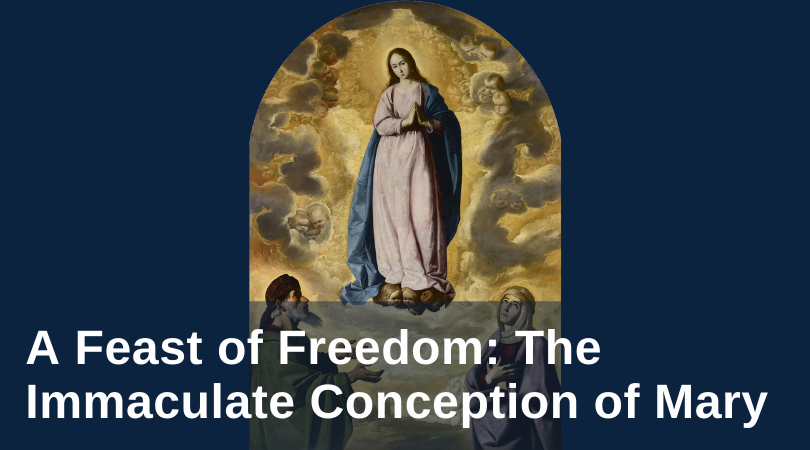
Today the Church celebrates the Solemnity of the Immaculate Conception. Occasionally this dogma is confused for the doctrine of the Virgin Birth of Jesus. According to the Catechism, the dogma of the Immaculate Conception pertains to the “splendor of an entirely unique holiness” that, among humans, belongs only to our Blessed Lady, because she is “enriched from the first instant of her conception”—a singular grace coming wholly from Christ. Mary is “redeemed, in a more exalted fashion, by reason of the merits of her Son” (CCC, §492).
The Catechism also tells us, “To become the mother of the Savior, Mary was enriched by God with gifts appropriate to such a role. The angel Gabriel at the moment of the annunciation salutes her as ‘full of grace.’ In fact, in order for Mary to be able to give the free assent of her faith to the announcement of her vocation, it was necessary that she be wholly borne by God’s grace” (CCC, §490). To be free, Mary needed God’s grace. Indeed, Mary is the perfect exemplar of the truth that God’s grace does not inhibit our freedom, but instead makes us free: free for goodness, free for others. As Pope Benedict XVI reminded the faithful on this great feast day back in 2005, “the person who abandons himself totally in God’s hands does not become God’s puppet, a boring ‘yes man’; he does not lose his freedom. Only the person who entrusts himself totally to God finds true freedom, the great, creative immensity of the freedom of good. . . The closer a person is to God, the closer he is to people. We see this in Mary. The fact that she is totally with God is the reason why she is so close to human beings.”
In recent months a series called The Chosen has been airing on YouTube. The show explores the possible back stories of Jesus’ disciples. Jonathan Roumie, the actor who portrays Jesus, happens to be a devout Catholic. In fact, Jonathan took to social media during the pandemic lockdown, reaching out to fans by leading the Rosary or Divine Mercy Chaplet each afternoon. In the fifth episode, entitled The Wedding Gift, Jesus and his disciples make their way toward the wedding at Cana. Some discussion—light banter, really—comes up about power, influence, and authority. Jesus tells his friends that they are about to meet “the most powerful person he knows”—his Mother.
This ease in relating to Mary, of considering her not only as powerful, but also personal, is a hallmark of the relationships so many saints have with her. I cannot help but be reminded of the quote from St. Thérèse of Lisieux: “She is more Mother than Queen.” Let us not be fooled into thinking that Mary’s tenderness and docility to God's will is a form of weakness that relegates her to the background in salvation history. The Blessed Mother wields more influence than any woman who has ever lived. With Mary at our sides—indeed in our hearts—no battle is too great, no woe too deep, for her maternal care.
The Church, in her wisdom, places Mary before us as the model of holiness and discipleship. Her faith, perseverance, obedience, docility, hope, trust, and love are examples for every Christian. St. Louis de Montfort, that great saint and devotee of the Blessed Virgin Mary once wrote, “The Son of God became man for our salvation but only in Mary and through Mary.” The teachings of the Second Vatican Council likewise remind us that acknowledging Mary’s role in salvation takes nothing away from Jesus Christ (see Lumen Gentium, chapter 8). Mary, as we’ve seen, plays an integral role in the life of the Savior. Our Father prepared her from all eternity to become the Mother of his Son.
What is it that God is preparing us for? The same loving God who formed and fashioned the Blessed Virgin Mary has a plan for you and for me. What is it? How is God forming you? Today, as we contemplate Our Lady, may she intercede for us that we may have eyes to see and ears to hear what the Lord has prepared for us. How blessed we are to have a Heavenly Queen, Our Blessed Mother, who will intercede for us along the way.
Like what you read? Submit your email below to have our newest blogs delivered directly to your inbox each week.
Featured image: Francisco de Zurbaran, The Immaculate Conception with Saint Joachim and Saint Anne (ca. 1638–1640); PD-OLD.


